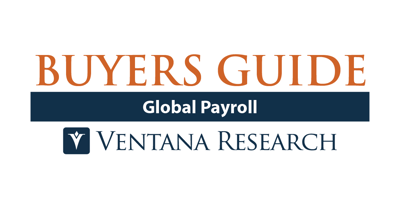Global Payroll Buyers Guide: Market Observations
The 2023 Ventana Research Buyers Guide for Global Payroll research enables me to provide observations about how the market has advanced.
The payroll preparation process has long been an inefficient, labor-intensive set of administrative tasks designed to ensure that everyone is paid correctly and on time.  Historically, it has been a transactional- and compliance-centered function involving manual adjustments, reconciliations and the answering of repeated routine questions. Now, advances in digital technologies and delivery models have rendered the payroll function considerably more efficient with the added bonus of delivering new value to the business through automation, data-driven decision support and direct contribution to an enhanced employee experience.
Historically, it has been a transactional- and compliance-centered function involving manual adjustments, reconciliations and the answering of repeated routine questions. Now, advances in digital technologies and delivery models have rendered the payroll function considerably more efficient with the added bonus of delivering new value to the business through automation, data-driven decision support and direct contribution to an enhanced employee experience.
Nowhere is this more important than in the delivery of global payroll. Managing payroll on a global scale presents a multitude of complexities and challenges that demand meticulous attention to detail. The first and most apparent obstacle is the sheer diversity of local regulations, tax laws and labor practices across countries. Each jurisdiction has its own unique requirements for payroll calculations, deductions and compliance, making it a daunting task for organizations with a global workforce. Additionally, currency exchange rates, language barriers and varying payment methods add further layers of intricacy to the process.
To address these complexities, organizations have several approaches at their disposal. Some opt for a fully in-house model, where they build and maintain their own payroll infrastructure. Others choose to outsource their payroll to global payroll providers who specialize in navigating global payroll, generally through a network of local, in-country providers. A third approach is the hybrid model, which combines in-house and outsourced components to strike a balance between control and expertise. The choice of approach often depends on factors like the organization’s size, geographical spread and internal know-how.
Software vendors play a crucial role in simplifying global payroll processes. They are developing systems that can harmonize payroll calculations across multiple countries, ensuring compliance with local regulations. These systems often include features like automated tax calculations, multi-currency support and built-in reporting and analysis tools. Moreover, many software vendors offer a hybrid approach themselves, managing payroll directly in some countries while partnering with local in-country providers in others. This hybrid approach can be a significant benefit as it leverages the vendor’s expertise and user experience while maintaining flexibility and compliance on a global scale. In essence, software vendors are central to addressing the complexities of global payroll, offering organizations the tools they need to streamline and optimize this critical function.
In our view, this technology-mediated shift to a new style of payroll management is well worth the effort. We advise that organizations seeking improvement embrace an integrated approach that not only optimizes the payroll function but also connects payroll with other core HR, talent management and workforce management systems and their related information and processes. With this integration in place, organizations can make better and often more strategic workforce-related decisions using payroll-related data such as overtime hours worked, PTO, types of bonuses paid, benefits participation rates or the ratio of regular to contingent worker costs.
According to the traditional understanding of payroll management, an organization either gets it right, completing payroll runs accurately and on-time, or does not. But modern payroll systems shake up this conventional wisdom through an array of approaches that deliver variable added value. While gross-to-net calculation engines may still deliver the same results, processing speeds can vary greatly, as can a particular software product’s ability to detect and resolve errors without restarting the calculation cycle.
Several recent technological advances in particular have significantly reduced the time it takes to complete a payroll cycle. These advances not only include faster processing speeds but also robotic process automation, artificial intelligence and machine learning (AI/ML) that can instantly predict, detect and correct errors, and chatbots that can field workers’ routine questions. And with the application of generative AI, these chatbots have become even more conversational, making responses personal to the specific employee rather than issuing a generic company-wide response that may still require a phone call or a help ticket with an HR service center.
To varying degrees, vendors also differ in their software’s ability to seamlessly maintain compliance and consolidate reporting and analytics across multiple regions: national, state, local and everything in between. Tax calculations, from federal to state to local school district, must be accurate and, importantly, regularly updated and maintained. This is no small task and requires considerable commitment and expertise on the part of the vendor. Similarly, the ability to manage the full complement of garnishment types, generate mandatory reporting for ACA and other federal programs, and perform calculations and audits for ever-changing minimum wage and overtime regulations should all be table-stakes capabilities of any domestic payroll software, but not all perform to the same standards.
Over the last three decades, payroll management was widely outsourced. As a result, most of payroll management operations were either partially or completely severed from other human capital management (HCM) processes. This isolation prevented organizations from using payroll information and planning in strategizing. Organizations were not readily able to utilize payroll data to manage important initiatives such as pay-for-performance strategies, optimizing worker schedules or pay equity analyses.
Now, however, technology can integrate the various aspects of HCM, connecting HR, payroll, talent and workforce management information and processes. Furthermore, analysts, managers and executives can apply powerful analytics tools to enable better-informed decisions. More recently, tools such as robotic process automation, natural-language chatbots, now often referred to as co-pilots or assistants, and AI-enabled predictive and personalization capabilities are contributing to easier and more effective workforce management. These advances have also played a significant part in enabling organizations to work toward providing a superior employee experience, increasingly a requirement for attracting and retaining top talent. Workers expect an engaging user experience when entering hours worked or pulling up a current or past pay stub to confirm earnings, taxes and deductions. In new payroll systems, intelligent virtual assistants can provide conversational user experiences, answering questions such as, “How do I fix a timesheet error?” or, “When will I receive my first check?” These questions may not be critical from a business perspective, but they are typically urgent for the employee, and with these new tools they can be addressed within seconds rather than requiring a game of phone or email tag that leads to frustration and disengagement.
Also in the realm of the employee experience, there have been significant advances in the flexibility of pay types, including the ability to pay via mobile-wallet, complemented by ancillary services such as targeted savings and financial wellness tools. Earned Wage access is another valuable tool that is becoming increasingly common, offering workers real-time access to a portion of the wages they’ve earned, providing a path away from predatory lenders and toward financial stability.
Over the past decade, the payroll function has become firmly established in the cloud. For organizations, this means more frequent updates and new releases without requiring organizations to retrofit customizations. Consequently, cloud-based services generally mean less reliance on an IT department to manage implementations. Further, vendors are increasingly offering no-code or low-code configuration options, thus bypassing the need for IT intervention at all. Nevertheless, small and midsize organizations continue to gravitate toward less sophisticated systems that provide reliability at a moderate cost, as offerings laden with innovative features often require a dedicated HR team to manage the deployment. Fortunately, vendors of all sizes are improving their offerings to include more sophisticated and valuable tools and functionality that are elevating the roll of payroll within organizations.
This research evaluates the following vendors that offer products that address key elements of global payroll as we define it: ADP, Ceridian, CloudPay, Gusto, Infor, Neeyamo, Oracle, Papaya Global, Paylocity, Rippling, SAP, UKG and Workday.
You can find more details on our site as well as in the Buyers Guide Market Report.
Regards,
Mark Smith
Authors:

Mark Smith
Partner, Head of Software Research
Mark Smith is the Partner, Head of Software Research at ISG and Ventana Research leading the global market agenda as a subject matter expert in digital business and enterprise software. Mark is a digital technology enthusiast using market research and insights to educate and inspire enterprises, software and service providers.










